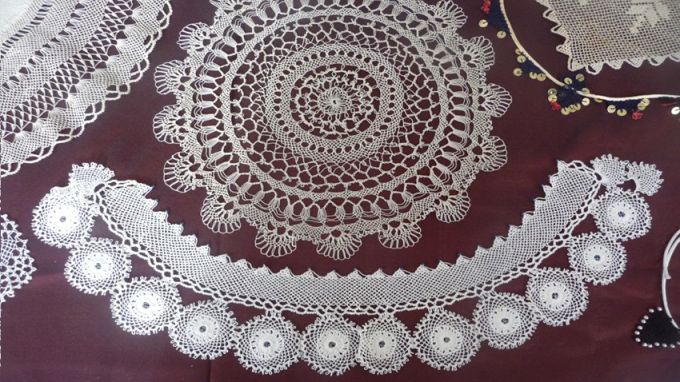 6
6
In 1909 a young girl from Kalofer, Donka Shipkova left for Sofia to learn the art of point lace. Having graduated the two year course in just one year, the energetic and enterprising young woman returned to her home town to pass her skills onto other young women. But she discarded the mandatory point lace standards, creating models all her own with typically Bulgarian stylized elements. On their part, the girls Donka tutored added more original motifs and so a new typically Bulgarian art form was born – Kalofer lace. Through the years, the art was passed on from mother to daughter, from grandmother to granddaughter to come down to us in our day.
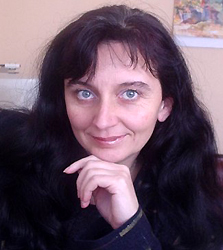 On Lace Day, marked in Kalofer on 15 August, we talked to master lacemaker Annie Yoveva:
On Lace Day, marked in Kalofer on 15 August, we talked to master lacemaker Annie Yoveva:
There are two types of lace that are most popular in Bulgaria – Kalofer lace and kene (also known as Armenian lace). What is the difference between them?
“Kalofer lace is made using shuttles and a cylinder; it is a sophisticated kind of lace, made with mathematical precision, whereas 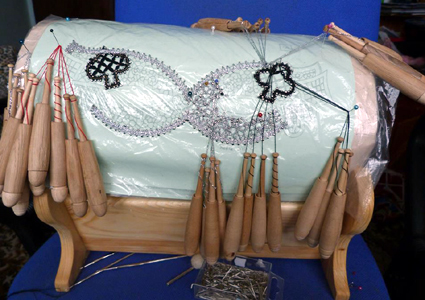 the tatted lace is made using a sewing needle and thread and needs no other preparatory material. The other difference is that there is no ready pattern that can be used; whereas with Kalofer lace there is a pattern fitted onto the cylinder and all of the knots used are indicated. With needle lace it is really difficult to attain perfection. It is made using knots, and the knots are never untwined, they are cut. If you make a mistake – you cut the knot and go on.”
the tatted lace is made using a sewing needle and thread and needs no other preparatory material. The other difference is that there is no ready pattern that can be used; whereas with Kalofer lace there is a pattern fitted onto the cylinder and all of the knots used are indicated. With needle lace it is really difficult to attain perfection. It is made using knots, and the knots are never untwined, they are cut. If you make a mistake – you cut the knot and go on.”
Once women in Bulgaria made lace using cotton or silk thread. The thinner the thread, the finer the lacework. Light colours were used – white, beige; in our day pale blue and purple is also used, for flowers brighter colours are also included. Lace is different in the different parts of Bulgaria.
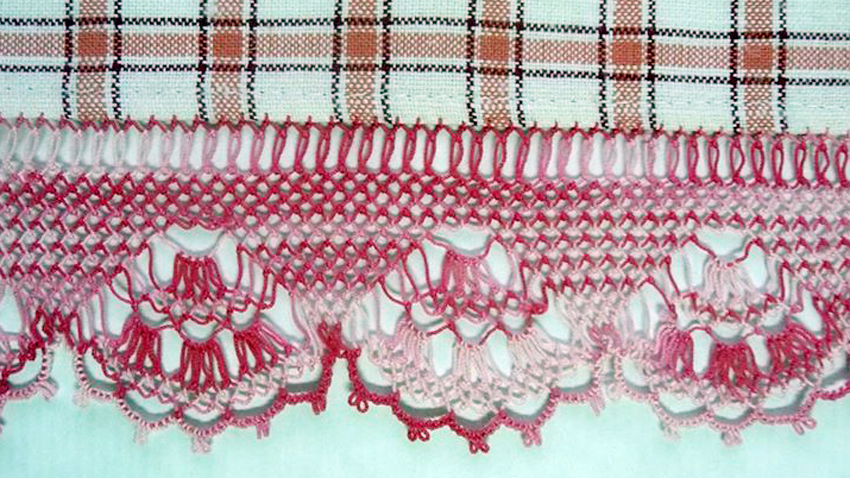
“In Kyustendil two kinds of kene lace is made. The first kind leaves more air between the elements and is more imaginative. The other type is a more compressed, compact kind of lace. It is used for ornaments known as “horo dancing” – depicting people holding hands. In the region of Samokov there is additional knitwork after the lace has been sewn - additional ornamentation is added inbetween the threads. In the Rhodopes lace is more compact and woolen thread is used. In Samokov wool is also used, mostly for aprons and the colours are green and orange, depending on what colour the skirt is,” says Annie Yoveva.
The only knitwork with horsehair woven into it is to be found in Koprivshtitsa. “The horsehair cannot in fact be seen with the naked eye, it is woven into the silken threads used and makes the lace much more sturdy and stiff. It is unparalleled!” says Annie Yoveva and adds:
“This kind of lace still holds secrets we have not unraveled – there are no master lacemakers left who could pass it onto the next generation. They used to make it following the principle: one woman does the first part then another woman takes over for the second part and a third – to finish off. So, there was no one single person who knew all of the stages of its making. More’s the pity.”
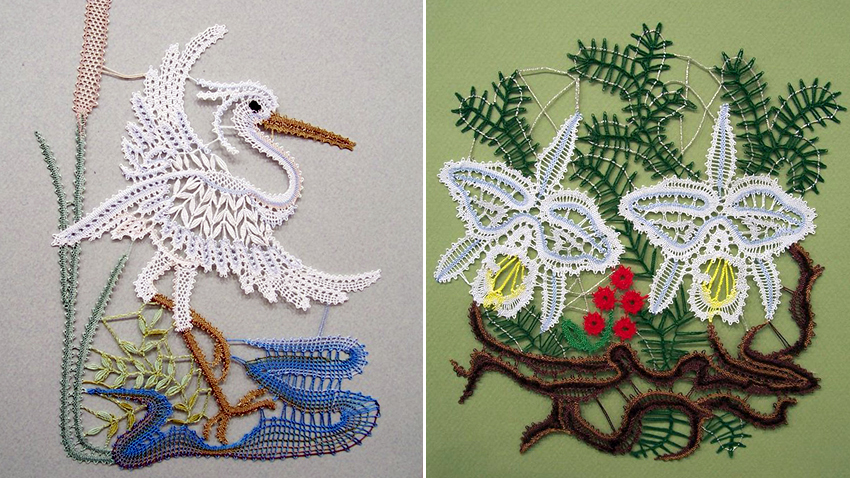
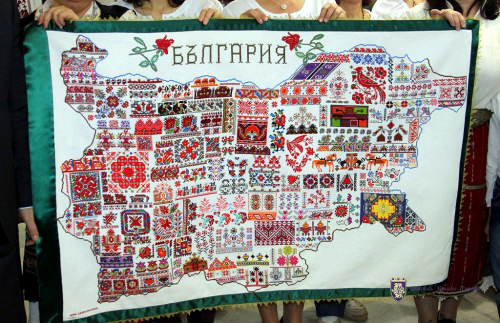 The fine lacework once adorned sleeves, bodices, headscarves. Clothes used to be passed on from mother to daughter, the fabric would tear, so the lace was taken off and stitched onto the new item of clothing - that is how it was left for posterity. But nowadays lacework is used for household objects as well – napkins, bedlinen and shawls, bedspreads and tablecloths, jewellery and even whole pictures.
The fine lacework once adorned sleeves, bodices, headscarves. Clothes used to be passed on from mother to daughter, the fabric would tear, so the lace was taken off and stitched onto the new item of clothing - that is how it was left for posterity. But nowadays lacework is used for household objects as well – napkins, bedlinen and shawls, bedspreads and tablecloths, jewellery and even whole pictures.
The secret of Bulgarian lacemaking and the skills it takes will certainly not vanish - interest in Kalofer and in kene lace has been rekindled thanks to different societies and organizations that have been working towards the preservation and popularization of traditional Bulgarian embroidery and lacework. In April the Sedyanka (working bee) workshop put on display a unique flag with 140 different kinds of embroidery on it from all folklore regions of Bulgaria. It took them one year to make it, with the help of Iren Yamami who has been living in Japan for many years as well as Japanese girls from the Bulgarian embroidery school there. The exquisite embroidery which makes the flag complete is the work of lacemakers from Bulgaria. The hemming is kene lace. It took Annie Yoveva and Galya Stoycheva four days to make the 5-meter lace, putting their heart and their soul into their work. The other embroidery on the flag is Kalofer lace – two red roses, the symbol of Bulgaria – made by Margarita Boneva and Dr. Lyubka Lyubenova.
English version: Milena Daynova
Photos: courtesy of Annie Yoveva and the Sedyanka WorkshopBulgaria will have a special day in British Columbia and in the city of Vancouver. May 24 will be declared Bulgaria Day. This was announced by Velislava Panova, Consul General of Bulgaria in Toronto . Velislava Panova pointed out that the..
''The government's term of office is short. It would be very difficult for someone who is completely unprepared'', caretaker Minister of Culture Nayen Todorov said in response to a question why he had accepted this position for the second time...
Well over 30 artists and performing arts and climate experts from several countries in Central and South-Eastern Europe - Bosnia and Herzegovina, Bulgaria, Poland, Hungary, North Macedonia, Serbia, Croatia and Montenegro - have arrived in Sofia to take..
Bulgaria will have a special day in British Columbia and in the city of Vancouver. May 24 will be declared Bulgaria Day. This was announced by..

+359 2 9336 661
